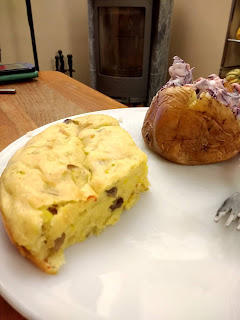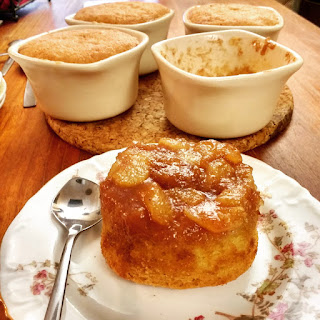A few years ago, when faced with a glut of pears from my parents' garden, I had a go at making a vegan alternative to honey. Some people are surprised that vegans don't eat honey but as this is a product made by bees and they don't eat anything that comes from animals, they don't eat it.
Honey is essentially sugar so it no surprise that a vegan alternative to honey needs plenty of sugar. My recipe also calls for pears and pineapple juice and after several hours of simmering, it produces a gloopy golden liquid not too dissimilar to honey. The technique requires makes me marvel all the more at bees!
Once strained off, there are also some cooked sweet pears remaining so I decided to blend these into a smooth paste, which was actually quite like set honey. So I made "runny honey" and "set honey" from the same batch, which was quite satisfying.
Having made the stuff, it proved a little tricky to sell. It was, of course, popular with vegans but they are only a small percentage of the population so only an occasional visitor to my stalls at craft fairs. However, other visitors to my stall often picked it up because they were looking for actual honey and then I had to explain what it was as it wasn't honey and, apart from tasting similar, doesn't have the properties to it that people often associate with honey.
In the end, I found it sold best when my friend Debbie, from Minkiemoo put it on her stall at dedicated vegan markets. She, however, has since moved to Cornwall!
This year my own pear tree decided that after eight years of not cropping, now was a good year to go crazy. So for the first time I had an abundant crop of pears of my own to process.
Pears don't make particularly good jam on their own because they are low in pectin and don't want to set. So I made a batch of Orchard Fruit Jam with apples, pears and plums, and I used some in Autumn Orchard Chutney too. But what about the rest?
I thought back to the vegan honey alternative recipe as this requires a kilogram and a half of pears but I have a rule not to turn one glut into another glut. That's to say, what is the point of turning a glut of pears into a glut of vegan honey? With no events on this year and Minkiemoo in Cornwall, how exactly would I reach vegans to sell it?
At the same time, my mum's tree had also had a good cropping year and she was busy making her pears into preserves - mostly a pear and ginger chutney from a recipe she had found on the internet. She asked me if I thought she should make pear jam but she said she didn't really eat much jam anyway, preferring honey and caramel sauce when she wanted something sweet. Well then, it seemed only logical that she could turn her glut of pears into a year's supply of "honey" for her own needs so I sent her the recipe.
Having put the idea of caramel sauce in my head, I started to wonder if it would be possible for my mum to meet her caramel requirements using her pears too. I mean, sticky toffee pudding is mostly made from dates, so maybe a pear/date concoction would be the answer.
I decided to experiment.
Sortly afterwards I had made my test batch of pear caramel and it was gorgeous! Inspired, I explored the possibilities and adapted my vegan honey into another sort of sauce and then fiddled with the ingredients until I had created a ginger version too.
Honestly, I would be happy to lick these off the spoon but they are absolutely perfect poured over ice-cream or drizzled on pancakes and waffles. And better still, with nothing other than fruit and sugar in them, they are suitable for vegans and allergy sufferers too! And there seemed to be endless possibilities for ues. So often pears seem to be paired with caramel or biscuit spread in recipes and I had created a caramel sauce out of pears so what could be more perfect?!
My first cooking recipe using the caramel sauce was a batch of ginger pear muffins. When I had last made the recipe I had used some biscuit sauce that I had been given so this time I used pear caramel and, my goodness, they were the softest, pillow-like muffins I have ever created.
Pear & Ginger Muffins (makes 12)
200g plain flour
1 tsp baking powder
1/2 tsp bicarb
Pinch of salt
125g light brown sugar
1 tsp ground ginger
1/2 tsp ground cinnamon
2 eggs
175ml sunflower oil
4 ripe pears, yielding 200g grated fruit
100g pear caramel (or biscuit spread)
Preheat oven to 180°C. Put all the dry ingredients in a bowl and stir. Put the eggs and oil in a jug and beat. Grate the pear onto the dry ingredients then pour in the pear caramel. Stir everything together then spoon into muffin cases and bake for 25 minutes.
My next flash of inspiration came on Sunday evening when I was thinking I really fancied a dessert with our Sunday roast. I had been processing fruit and vegetables all weekend but there were 6 over-ripe pears still lurking on the side telling me that I hadn't quite ticked everything off my to-do-list. So I peeled two, whipped up a sponge pudding batter and dolloped slice of pear with spoonfuls of pear caramel into the bottom of four ramkins. When the roast came out of the oven, the puddings went in and just as we came to the end of dinner, they were cooked and ready to serve. And, oh my goodness, they were delicious!
Pear Caramel Sponge Puddings (serves 4)
115g margarine
115g caster sugar
1/2 tsp vanilla extract
2 eggs
115g self-raising flour
2 ripe pears
100g pear caramel (or use caramel or syrup)
Preheat oven to 170°C and butter 4 ramekins. Cream together the margarine and the caster sugar then add the vanilla and eggs and mix well. Stir in the flour to make a batter. Peel and slice the pears and distribute evenly into the four ramekins. Divide the pear caramel between the ramekins too, just coating the pears. Spoon over the cake batter then bake for 25 minutes. Tip out of ramekins so that the pears are at the top and serve warm as it is or with custard or cream.
I reckon a little tweaking of the sponge mix to include brown sugar and some ground ginger, these would work very well paired with the ginger dessert sauce too.
Anyway, there's a few things for you to think about here and lots of scope to get creative with desserts so I would recommend that you get yourself some delicious pear dessert sauce - or all three!





















































